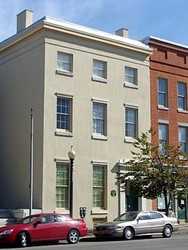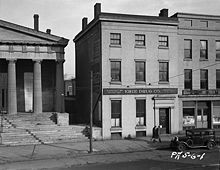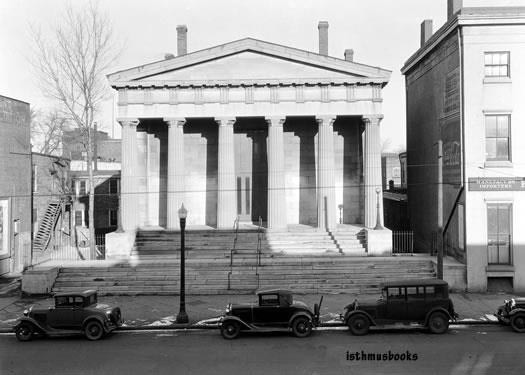Cashier's House
Introduction
Text-to-speech Audio
This 1839 structure was part of a three-building banking complex that included what is now the Old Customshouse, and Coach House. This building housed the CEO of the Erie branch of the Bank of United States located next to the complex. When the branch closed down in 1841, the house continued to act as a residence until 1913. From then until 1963 it was sparsely used until the city of Erie purchased the building and restored it. Currently it is being used by the Erie County History Center.
Images
Cashier's House today

Cashier's House in 1934

Customshouse with portion of Cashier's House to the right. Early 1900s photo

Backstory and Context
Text-to-speech Audio
The Cashier's House was designed by Philadelphia-architect William Kelly and was built as part of a three-structure complex, in 1839. The Coach House and Old Customshouse were also part of the complex. It was built primarily as the residence for the chief executive officer of the next door Erie Branch of the Bank of the United States. The bank closed in 1841, but the cashier of the bank continued to live in the house until his death in 1843. In 1850, the house was sold for $4,000 ($101 thousand in present-day terms) at half of its original cost. The Cashier's House was bought by Samuel Woodruff in 1872. The Woodruffs occupied the Cashier's House until 1913, leading the house to sometimes be referred to as the "Woodruff Residence" or "Woodruff House.
The state of Pennsylvania bought the Cashier's House on July 17, 1963 for $30,800 ($237 thousand today). The state restored the Cashier's House, and the next-door Old Customshouse, in the late 1960s and early 1970s. On March 9, 1983, the boundary of the site was increased to include the Coach House.
The Coach House, located on East 4th Street, was built at the same time of the Old Customshouse and the Cashier's House. The house was sold to a marble dealer in 1882 and was sold, again, in 1904 to a Blacksmith. The depth of the house was expanded to nearly triple the original size by the Blacksmith to house heavy machinery.
The state of Pennsylvania bought the Cashier's House on July 17, 1963 for $30,800 ($237 thousand today). The state restored the Cashier's House, and the next-door Old Customshouse, in the late 1960s and early 1970s. On March 9, 1983, the boundary of the site was increased to include the Coach House.
The Coach House, located on East 4th Street, was built at the same time of the Old Customshouse and the Cashier's House. The house was sold to a marble dealer in 1882 and was sold, again, in 1904 to a Blacksmith. The depth of the house was expanded to nearly triple the original size by the Blacksmith to house heavy machinery.
Sources
"National Register of Historic Places -- Nomination Form." U.S. Department of the Interior. 1983. Accessed July 15, 2016. http://www.livingplaces.com/PA/Erie_County/Erie_City/Erie_Federal_Courthouse.html
